Description
Wallpaper remnants are available for the cost of £0.1/cm.
£240 Original price was: £240.£74Current price is: £74.
Remnants of wallpaper that can be purchased for small projects. Sold for £1 per linear 10cm with the standard width of 70cm. This rolls is 735cm long (the full roll is 10m).
Out of stock
Wallpaper remnants are available for the cost of £0.1/cm.
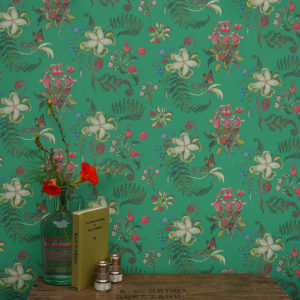

(This offer refers only to the wallpaper we have in stock.)
The Carolina Tree of Life collection celebrates the natural history of the Carolinas in the American South, where biologist and designer Susy Paisley spent much of her childhood. Carolina Posies is a lush, hand-drawn design which celebrates wild species of the Southern States of the Carolinas. The designer is a conservation biologist who grew up in this beautiful area. The rich colors and graphic details are matched by the interest of the many extraordinary species depicted, including monarch butterflies and their larval foodplants, milkweed, Carolina Reaper chilli peppers, devil’s paintbrush, pine barren gentian, grass of Parnassus and carnivorous plants. It is a detailed botanical with an enchanting meandering feel.
Companion prints include Carolina Tree fo Life and Carolina Monarchs,
featuring details from this larger scale design.
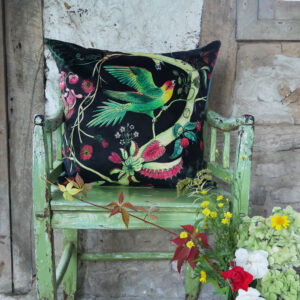
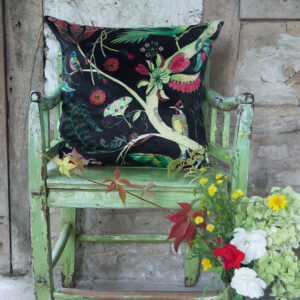
This colourful linen velvet is an ususual and lustrous fabric, woven in the Netherlands and printed in Glasgow using reactive dyes, and sewn in Whitstable. The cushion pad is made in the UK.
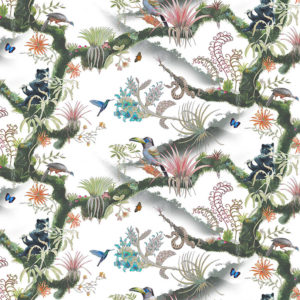
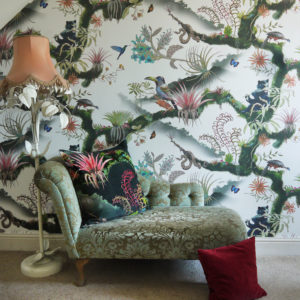
Stock sale
The Andean spectacled bear, a mysterious and endangered species and inspiration for Paddington Bear, was the focus of my years of study in the Andean cloud forest of Bolivia’s Madidi National Park. During long periods spent alone for my research, I became obsessed with the intricate patterns and colour around me. Lichens, thin-lipped frogs, hummingbirds and toucans, along with my bears, were the subjects of my detailed drawings, and have formed the basis of this design. The composition of the design itself was inspired by a Josef Frank design from 1938 called Anakreon. His design was based on a 3,500-year-old fresco, discovered by a friend of Frank’s, from the palace in Knossos on Crete.
The design repeats once across the 70cm width of the wallpaper on the medium scale design. This design is also available in a large scale on a wide width wallpaper, at 137cm.
With exquisite botanical detail, this design builds on biophilic passion in interiors for honouring the natural world. Furthermore, for every roll of wallpaper sold, 100m2 of critical wild Habitat is preserved through World Land Trust.
This is an eco-friendly Fine gicleé digitally-printed “real” wallpaper. It is printed in the UK on a natural non-woven cellulose-based substrate made from recycled materials – recycled polyester (PET) fibre and recycled wood pulp. The production process is solvent free with minimal waste and energy inputs.
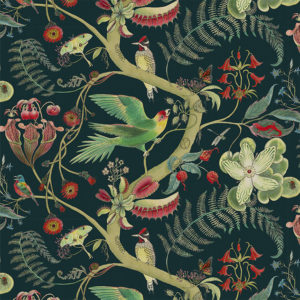
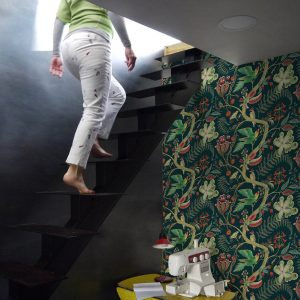
The Carolina Tree of Life collection celebrates the natural history of the
Carolinas in the American South, where biologist and designer Susy Paisley
spent much of her childhood. This design inspiration comes from free-flowing
17th Century tree of life prints. It depicts flora and fauna of the region
including: the extinct Carolina parakeet feeding on cockleburrs, and the
Monarch butterfly (whose milkweed dependent migratory life cycle is critically
endangered). Also present are carnivorous native plants such as the Venus
flytrap and the Mountain Sweet pitcher plant and wildflowers like the Devil’s
paintbrush, Grass of Parnassus and Gray’s lily. Flying creatures include a
Yellow-bellied sapsucker, a Luna moth and a Painted bunting. The black-
chinned red salamander is native to the southern Appalachians, which
have the greatest diversity of salamanders in the world.
Companion prints include Carolina Posies and Carolina Monarchs,
featuring details from this larger scale design.
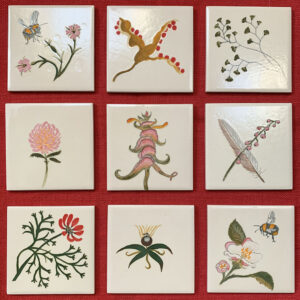
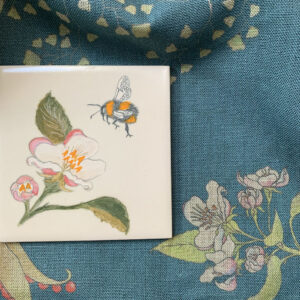
Please consult with us about your project. The basic cost is £35 / tile with a MINIMUM OF 6 TILES. The tiles pictured here were for a commission to coordinate with the Mercia Vines collection. Every tile is unique, and if multiples are ordered of the same design, each one would be slightly different.
For reference, these tiles can be identified as:
A – Nightingale feather
B – Clover
C – Maidenhair fern
D – Stinking iris pod
E – Pheasant’s eye small
F – Crested cowheat
G – Short-haired bumblebee and pinks
H – Herb Paris
I – Red squirrel tail
J – Pheasant’s eye larger
K – Whorled snail
L – Apple blossom and bumblebee